As dog owners, we want nothing but the best for our furry friends. We make sure they have the best food, the most comfortable beds, and plenty of toys to play with. But when it comes to feeding our dogs human food, we have to be careful. While some foods are safe for dogs to consume in moderation, others can be toxic. One food that often gets overlooked when it comes to feeding dogs is cilantro. Cilantro is a popular herb used in many different cuisines around the world. But can dogs eat cilantro? The short answer is yes! Dogs can eat cilantro in moderation.
Knowing what foods are safe for your dog to eat is incredibly important. Feeding your dog something that is toxic or harmful can lead to serious health problems or even death. As responsible dog owners, it’s our job to research before adding any new food items into their diet. So let’s dive into the world of cilantro and dogs. Can they eat this tasty herb? And if so, what are the benefits?

What is Cilantro?
Cilantro is a leafy green herb that belongs to the same family as parsley and carrots. It has a distinct taste that some people describe as citrusy or slightly soapy. The plant is also known as coriander in some parts of the world, although in North America, coriander usually refers to the seeds of the cilantro plant rather than its leaves.
The cilantro plant has been cultivated for thousands of years and has a long history of use in both cooking and medicine. It is native to regions of Europe, Asia, and Africa but is now grown all over the world.
Definition and Brief History
Cilantro gets its name from the Spanish word for coriander, which comes from the Greek word “koris,” meaning bedbug. This is because the leaves of the cilantro plant have a slightly sweet aroma that some people find similar to the scent of bedbugs.
Cilantro has been used in traditional medicines around the world for centuries. In ancient Egypt, it was used as a medicine and was found in tombs dating back to 1000 BC. In traditional Chinese medicine, it was used to treat stomach problems and relieve pain.
Nutritional Value for Humans
Cilantro is low in calories but high in vitamins and minerals. A single cup (about 4 grams) of chopped cilantro contains
- Vitamin K: 258% of the recommended daily intake (RDI)
- Vitamin C: 6% RDI
- Calcium: 4% RDI – Iron: 4% RDI
- Potassium: 3% RDI In addition to these important nutrients, cilantro contains antioxidants that may help protect against cellular damage caused by free radicals.
Overall, cilantro is an excellent addition to your diet if you’re looking for a low-calorie way to boost your intake of vitamins and minerals. Plus, it adds flavor and freshness to a variety of dishes.

Can Dogs Eat Cilantro?
If you’re a dog owner and love to cook with fresh herbs, you might be wondering if cilantro is safe for your furry friend to eat. The good news is that cilantro is not toxic to dogs, and they can eat it in moderation. However, before adding it to your dog’s diet, there are some things you should know.
Yes, but in moderation
Cilantro contains many beneficial nutrients that can contribute to your dog’s health. It is rich in vitamins A and C, antioxidants, and anti-inflammatory properties.
However, like with any food, too much of a good thing can be bad for dogs. Overconsumption of cilantro can lead to digestive issues such as diarrhea or vomiting.
It’s important to note that while cilantro itself is safe for dogs, some of the ways it may be prepared or served may not be. For example, if cilantro is mixed with ingredients that are harmful to dogs like onions or garlic or served with a high-fat content food like cheese or bacon bits – this could cause an upset stomach.
Benefits of Cilantro for Dogs
Cilantro has several health benefits for dogs when consumed in moderation. One of the most noteworthy benefits of this herb is its ability to support dental hygiene by combating bad breath and tackling gingivitis. It’s also believed that incorporating cilantro into their diet may help strengthen their immune system due to its antioxidant properties which protect cells from damage caused by free radicals.
This herb has antibacterial compounds which may play a role in preventing infection by killing off harmful bacteria in the gut. Overall adding small amounts of fresh cilantro leaves into your dog’s meals occasionally could have multiple benefits as long as precautions are taken when doing so!
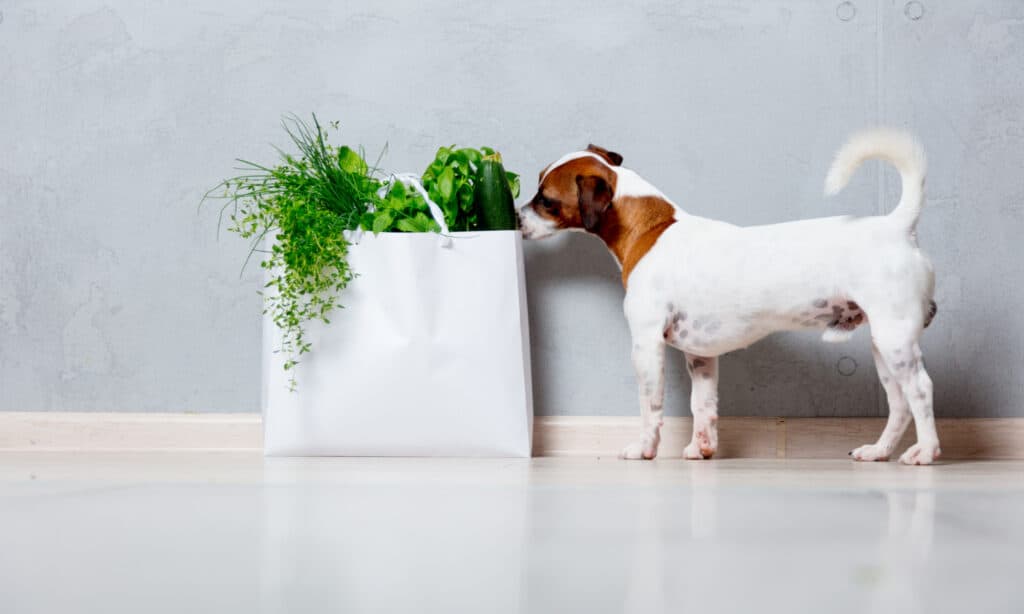
How to Serve Cilantro to Dogs
Cilantro can be a tasty and healthy addition to your dog’s diet when served in moderation. There are a few ways to serve cilantro to dogs, including chopped or pureed as a topping or mix-in for dog food and homemade dog treats with cilantro as an ingredient.
Chopped or Pureed as a Topping or Mix-In for Dog Food
If you want to add some variety and flavor to your dog’s regular meals, you can chop up some fresh cilantro leaves and sprinkle them on top of their food. Alternatively, you can blend the cilantro into a puree and mix it in with their food.
This is an easy way to give your pup the benefits of cilantro without having to make any major changes to their diet. When adding cilantro as a topping or mix-in for your dog’s food, it is important not to overdo it.
Too much cilantro can upset your dog’s stomach and cause digestive issues such as vomiting and diarrhea. A general rule of thumb is that 1-2 teaspoons of chopped or pureed cilantro per day is safe for most dogs.
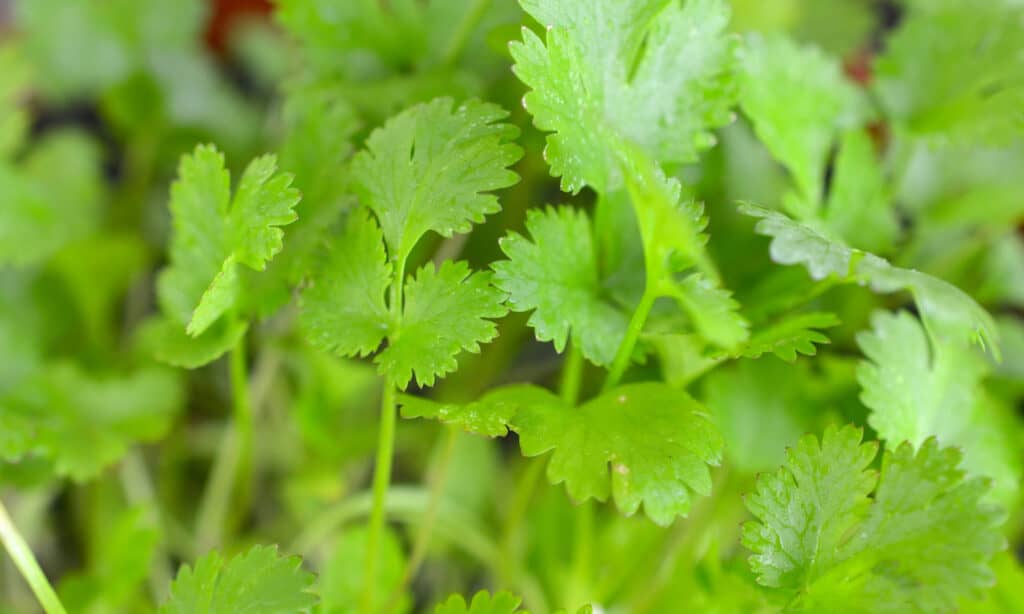
Homemade Dog Treats with Cilantro as an Ingredient
If you enjoy making homemade treats for your furry friend, consider incorporating some fresh cilantro into the recipe. Cilantro can add a unique flavor and aroma that many dogs love, making it a great choice for homemade snacks. A simple recipe for homemade cilantro treats involves combining 1 cup of flour, 1 egg, ¼ cup of fresh chopped cilantro leaves, and enough water to form a dough.
Roll out the dough on a floured surface and use cookie cutters to create fun shapes. Bake at 350 degrees Fahrenheit for 15-20 minutes, or until golden brown.
Remember to always supervise your dog while they are enjoying homemade treats and to store any leftovers in an airtight container in the fridge. Homemade treats should only be given in moderation as they can contribute to weight gain if overfed.
Serving cilantro to your dog can be a healthy and tasty addition to their daily diet. Whether you choose to add it as a topping or mix-in for their regular meals or incorporate it into homemade treats, make sure you do so in moderation and always supervise your dog while they are eating.
If you are unsure whether your dog will react well to cilantro or have any concerns about their diet, it is always best to consult with your veterinarian before making any changes. With a little bit of research and creativity, you can provide your pup with a variety of healthy and flavorful foods that they will love!

Precautions When Feeding Cilantro to Dogs
Possible Allergic Reactions in Some Dogs
While cilantro is generally safe for dogs to eat, some dogs may be allergic to it. In fact, it’s not uncommon for dogs to have allergies to certain types of food.
Signs of a cilantro allergy can include itchiness, skin rashes, and digestive issues like vomiting or diarrhea. If your dog shows any of these symptoms after eating cilantro, you should stop feeding it immediately and consult with your veterinarian.
It is always recommended that you give your dog a small amount of any new food first before giving them more. This way, you can watch out for any signs of an allergic reaction without putting your pup at risk.
Overconsumption Can Lead to Digestive Issues
While cilantro is safe in moderation, too much of anything can be harmful – even good things like healthy herbs! Overconsumption of cilantro can lead to digestive issues in dogs such as bloating and gas. To avoid overfeeding cilantro or any other herb to your dog, make sure you are giving them the right portion size based on their weight and size.
A good rule of thumb is that treats should make up no more than 10% of your dog’s daily calorie intake. It’s important also not to get carried away with how much fresh herbs or spices we add to our homemade dog meals without researching which amounts are beneficial and which ones can be harmful.
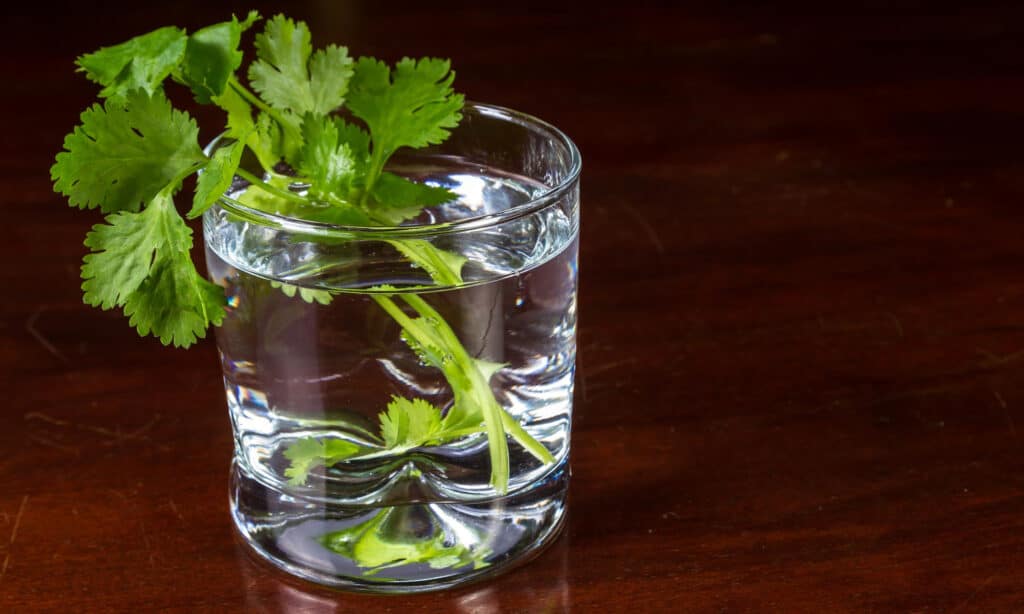
Cooked or Raw Cilantro?
Some pet owners prefer serving cooked cilantro as they believe it’s easier on their pet’s digestive system compared with raw leaves. Cooked leaves may have fewer essential oils that some animals find difficult to digest. However, there isn’t a clear nutrition benefit either way – both cooked or raw will still provide a range of vitamins and minerals for your furry friend.
Avoid Cilantro with Added Spices
Cilantro is a healthy herb but some packaged cilantro products can contain added spices or salt. These can be harmful to dogs, especially if they are already getting enough of these ingredients from their regular diet. When selecting cilantro, make sure you read the label and ingredients list before buying it to ensure that it’s free of added spices or preservatives.
Consult with Your Vet
If you’re still unsure about whether or not your dog can eat cilantro, consult your veterinarian. They’ll be able to advise you on which herbs are best for your dog and how much they should be eating based on their age, breed, weight, and overall health. Remember that every dog is different!

Other Herbs Safe for Dogs to Eat
Parsley
Parsley is a popular herb that is safe for dogs to eat. It contains vitamins A, C, and K, as well as calcium and iron.
Parsley can help freshen your dog’s breath, and some studies suggest that it may have anti-cancer properties. You can chop up parsley and add it to your dog’s food or use it as a garnish.
Basil
Basil is another herb that is safe for dogs to eat. It contains antioxidants and has anti-inflammatory properties, which can be helpful for dogs with joint pain or other inflammatory conditions.
Basil can also help improve digestion and relieve gas in dogs. You can add chopped basil to your dog’s food or use it in homemade dog treats.
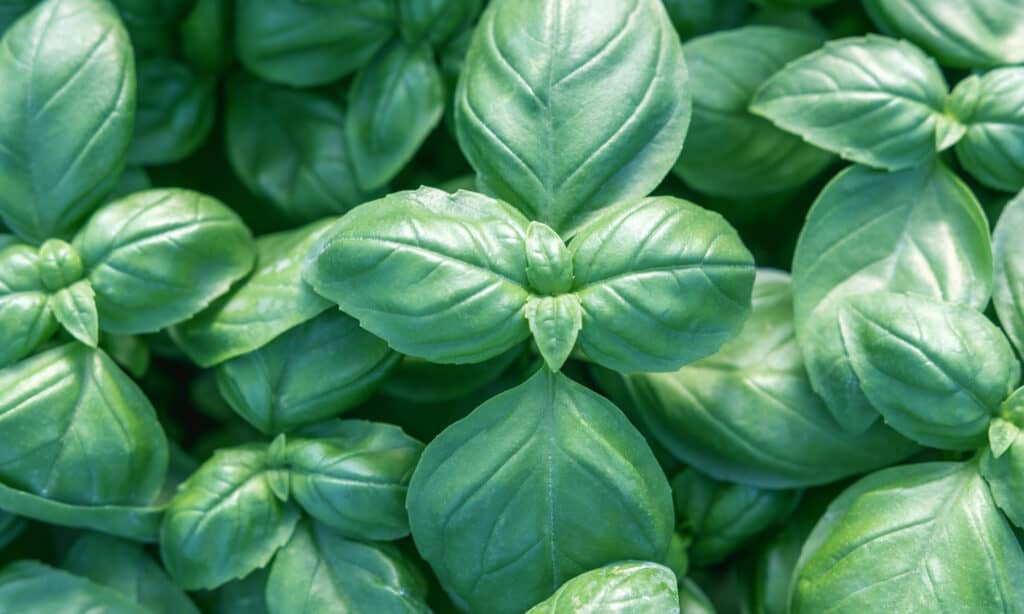
Thyme
Thyme is an herb that has a strong flavor and aroma. It contains thymol, which has antiseptic properties that can help fight infections in dogs.
Thyme also has anti-inflammatory properties and may be helpful for dogs with respiratory issues, such as coughing or bronchitis. You can add fresh thyme leaves to your dog’s food or make a tea out of thyme leaves and give it to your dog if they have respiratory issues.
Oregano
Oregano is an herb that is commonly used in Italian cuisine. It contains antioxidants and has antibacterial properties that may be helpful in preventing infections in dogs.
Oregano also has anti-inflammatory properties that may help relieve pain in dogs with arthritis or other inflammatory conditions. You can sprinkle dried oregano on your dog’s food or use it in homemade dog treats.

Rosemary
Rosemary is an herb that has a strong aroma and flavor. It contains antioxidants and has anti-inflammatory properties that can be helpful for dogs with joint pain or other inflammatory conditions.
Rosemary may also help improve digestion and stimulate the appetite in dogs. You can add fresh rosemary leaves to your dog’s food or use it in homemade dog treats.
There are many herbs that are safe for dogs to eat, including parsley, basil, thyme, oregano, and rosemary. These herbs not only add flavor to your dog’s food but also have various health benefits that can improve your dog’s overall well-being.
However, it is important to remember that every dog is different and may have different dietary needs or restrictions. Before adding any new foods to your dog’s diet, consult with your veterinarian to ensure that they are safe for your furry friend.

Conclusion
Cilantro can be a safe and healthy addition to your dog’s diet when given in moderation. Cilantro is packed with nutrients such as antioxidants and vitamins A and C, which benefit your dog’s immune system, eyesight, and skin health.
When feeding cilantro to your dog, it is important to prepare it properly, either chopped or pureed as a topping or mix-in for their regular food or as an ingredient in homemade treats. While cilantro is safe for most dogs to eat, it is important to know that some dogs may have allergic reactions to the herb.
Keep an eye on your dog’s behavior after consuming cilantro, especially if they are new to the herb. Overconsumption of cilantro can also lead to digestive issues such as diarrhea or vomiting.
If you are considering introducing any new food into your dog’s diet, it is crucial to research beforehand and check with your veterinarian before incorporating it. Additionally, always remember that every dog is different and may react differently even to foods considered safe.
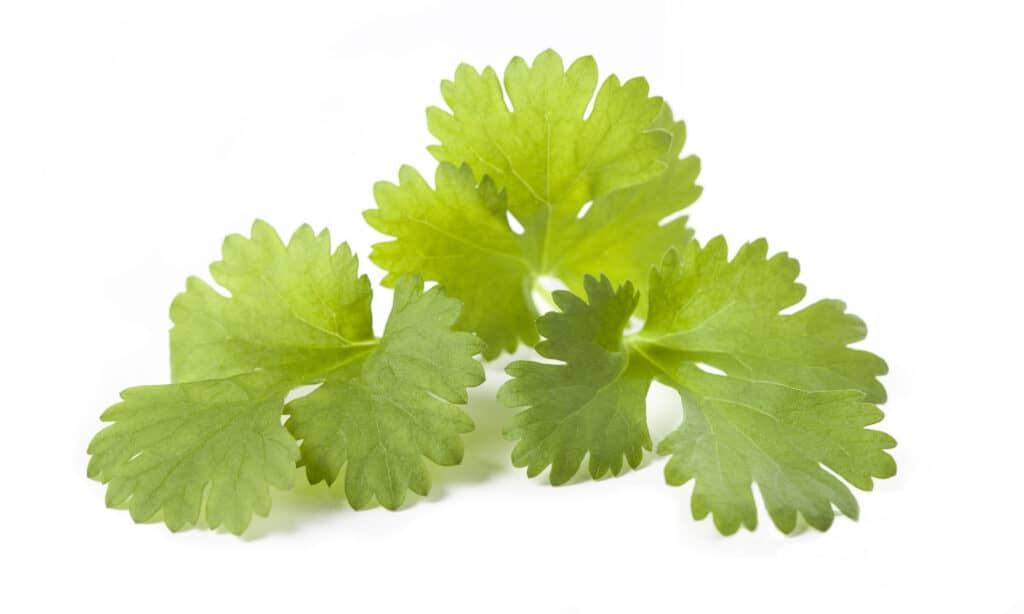
As a dog owner, you must prioritize your pet’s health and well-being. Knowing what to feed your dog and what to avoid can be overwhelming. However, taking the time to research and educate yourself on your pet’s dietary needs is a crucial part of responsible pet ownership.
By incorporating new foods like cilantro into your dog’s diet in moderation and with proper preparation, you can provide them with added nutrients that benefit their overall health. Remember, our furry friends rely on us to make the best choices for their health, so let’s do our best to keep them happy and healthy!
~Sheena
